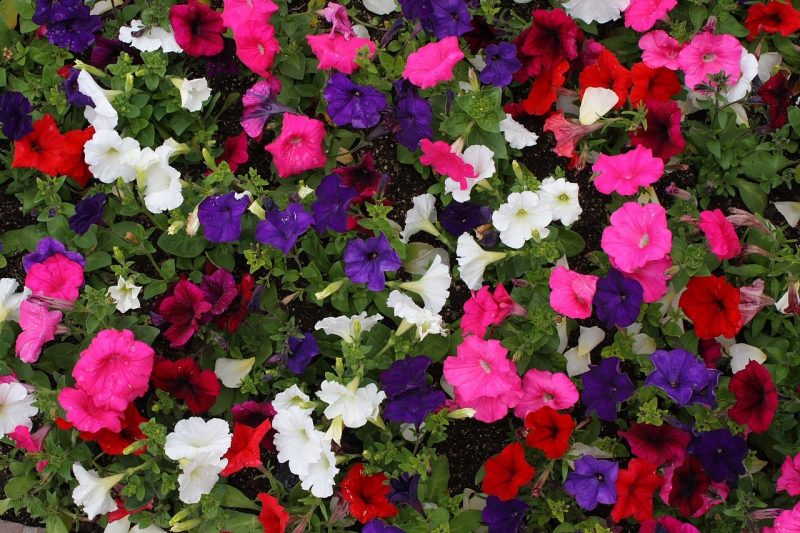Are you aware of what are the optimal temperatures in a greenhouse for growing petunias? It can be confusing at first because they differ for every growth stage. However, many university extensions are generous in sharing information for planting, rooting, and growing petunias in the greenhouse.
The effectiveness of a greenhouse in growing plants will only be possible with the practice of each plant’s ideal conditions. One of the significant factors that you have to maintain in growing petunias in the greenhouse is the temperature. Upon meeting these requirements, you can reap the benefits of greenhouse gardening amidst the conditions outside.

What Are The Optimal Temperatures In A Greenhouse For Growing Petunias: Gardener’s Guide
Below are different temperatures for planting, rooting, and growing petunias. You must maintain the greenhouse in these conditions and adjust accordingly, depending on your growing zone. The Missouri Botanical Garden mentioned that these flowers grow well in zones 10 to 11, so study your area’s rating beforehand.
Optimal temperatures for planting petunias
According to Iowa State University, you can start your petunia seeds in containers, but it’s crucial to maintain the location at 75 to 80°F for optimum seed germination. High temperatures above 90°F and direct sunlight can prevent germination. Once the seeds germinate after 7 to 10 days, the temperatures should be at 60 to 65°F.
Greenhouses are excellent for those who want to grow petunias from seeds since outdoor planting is more natural with transplants. But what are the optimal temperatures for petunias if you’re transplanting them from the greenhouse to the garden? The University of Minnesota Extension recommends waiting for the soil to warm up at 60°F to avoid damages from frost.
Besides, remember to lower the night temperatures at 63 to 65°F to prepare them for transplanting. Speaking of soil temperatures, Utah State University noted that maintaining the growing media in the greenhouse at 65 to 75°F, or 70 to 72°F in particular, leads to successful seed germination. In the greenhouse production of petunias in Auburn University, you can also maintain 75 to 78°F for the first five days, 68 to 75°F once you see cotyledons unfold, then 65 to 70°F when you see the real leaves.
And for the irrigation and mist in the greenhouse, use water at 70°F.
Optimal temperatures for rooting petunias
Sometimes, gardeners prefer rooting petunias instead of growing them from seeds. In this method, you want to root the plants for 2 to 3 weeks between 64 to 75°F. The advantage of rooting or using cuttings is that the plants you’ll grow are similar to the original and will bloom earlier.
Optimal temperatures for growing petunias
For growing and maintaining petunias in the greenhouse, remember the numbers for day and night temperatures. During the day, the temperatures should be 64 to 75°F and 55 to 64°F at night. However, there are some cases where petunias are hardy even at 95°F
Did you know that the plant height, flowering time, and lateral branching of petunias are affected by temperatures? Between 50 to 77°F, the highest temperature can make taller plants, hasten to flower, and lessen lateral branches. And if you have just transplanted petunias, experts recommend using 63°F for ten days first.
Other Greenhouse Requirements For Growing Petunias
Besides temperatures, there are some guidelines that you must meet with petunias in the greenhouse. Remember to use a light, well-drained soil with average fertility at a pH of 6.0 to 7.0. And for hardening petunias from the greenhouse to outdoor beds, use a sheltered area to help them adjust.
Once petunias are established, give up to 2 inches of water every seven days. Monthly feeding using a balanced fertilizer will also encourage growth and blooming. If your petunias stop flowering, prune the shoots but do not remove all of the leaves.
Using a liquid fertilizer and watering well will help with flowering. As for deadheading, double petunias and those with large flowers require removal of old and dying flowers. If you’re using cultivars with smaller flowers, they will usually do this themselves.
What problems can you expect in growing petunias? The good thing with this flower is it has a few issues such as aphids and slugs. Proper watering and humidity control can also address petal blight and other diseases.
What Is The Best Petunia For Greenhouse?
The Grandiflora singles, Multiflora singles, and their double flower forms are the most famous horticultural types of petunias. Grandiflora has large flowers, and many cultivars offer a wide range of colors, but the smaller Multiflora can withstand demanding conditions.
Conclusion
Many university extensions have written about the convenience and advantages of growing and producing petunias in a greenhouse. But do you know what are the optimal temperatures in a greenhouse for growing petunias? This is a crucial question as the greenhouse temperature plays a significant role in the success of petunias.
Each growing stage, whether during planting, rooting, or growing, has different temperature requirements. Failure to meet them can affect the germination, growth, and quality of your petunias. In general, 64 to 75°F at day and 55 to 64°F at night are best for growing petunias in the greenhouse. It would also help that you learn your planting zone to know the temperatures to expect in your area.
